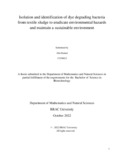| dc.contributor.advisor | Siddique, Ms. Romana | |
| dc.contributor.author | Kamal, Afia | |
| dc.date.accessioned | 2023-04-09T06:39:16Z | |
| dc.date.available | 2023-04-09T06:39:16Z | |
| dc.date.copyright | 2022 | |
| dc.date.issued | 2022-10 | |
| dc.identifier.other | ID: 13336012 | |
| dc.identifier.uri | http://hdl.handle.net/10361/18113 | |
| dc.description | This thesis is submitted in partial fulfillment of the requirements for the degree of Bachelor of Science in Biotechnology 2022. | en_US |
| dc.description | Catalogued from PDF version of thesis. | |
| dc.description | Includes bibliographical references (pages 68-71). | |
| dc.description.abstract | Bangladesh's textile industries contribute to the country's enormous wealth and prosperity, but they
are also silently destroying the country's water bodies and surrounding areas. Textile dye
wastewater is brightly colored and contains a wide range of chemicals, toxins, and heavy metals.
Under the Bangladesh Environment Conservation Act, 1995, and the Environment Conservation
Rules, 1997, the government designated textile dyeing industries as "red industries" (the most
polluting) and made Effluent Treatment Plants (ETPs) mandatory for the factories. However, the
majority of them lack ETP because chemical and physical methods require constant monitoring
and are extremely costly to operate. Industry is budding, and so is pollution. Microbial
bioremediation offers an easy and affordable solution to this problem and helps to maintain a
sustainable environment. Keeping the above situation in mind, research on isolating a dye degrading bacterium is preferred. In this study, one decolorizing bacterial isolate has been isolated
from industrial textile sludge with the ability to decolorize 1% of commercially available Reactive
Violet 5R (RV5R) dye. About 91.16% of RV5R dye was decolorized after 48 hours of incubation
at 370C and 80 rpm. The absorbance was measured at 510 nm for the supernatant with the help of
a spectrophotometer. The whole cell culture and the supernatant of the culture as an inoculate
showed the same result. The study was also conducted under aerobic conditions without using any
co-substrate and using the Reactive Violet 5R (RV5R) dye as the only carbon and energy source
for the bacterial isolate. The cultural, morphological, and physiological characteristics of that
bacteria isolate have been detected. Through analyzation with ABIS Microbiology software, the
isolate is identified as either Actinobacillus rossi (85.9% similarity) or Acromonas salmonicida
subsp. smithia (82.2% similarity). For further molecular identification, the DNA was extracted,
and PCR amplification of the 16S rRNA gene was conducted. The gel electrophoresis was
performed to check whether the band was present or not. The future goal is to identify the
bacterium isolate at the genomic level and identify the gene or genes that synthesize enzymes
capable of decolorizing textile dyes. If everything goes as planned, this bacterium will undoubtedly
contribute to the creation of a sustainable environment for our country. | en_US |
| dc.description.statementofresponsibility | Afia Kamal | |
| dc.format.extent | 71 pages | |
| dc.language.iso | en | en_US |
| dc.publisher | Brac University | en_US |
| dc.rights | Brac University theses are protected by copyright. They may be viewed from this source for any purpose, but reproduction or distribution in any format is prohibited without written permission. | |
| dc.subject | Dye Degrading Bacteria | en_US |
| dc.subject | Textile Sludge | en_US |
| dc.subject | Environmental Hazards | en_US |
| dc.subject | Sustainable Environment | en_US |
| dc.subject.lcsh | Textile industry--Environmental aspects. | |
| dc.title | Isolation and identification of dye degrading bacteria from textile sludge to eradicate environmental hazards and maintain a sustainable environment | en_US |
| dc.type | Thesis | en_US |
| dc.contributor.department | Department of Mathematics and Natural Sciences, Brac University | |
| dc.description.degree | B. Biotechnology | |

